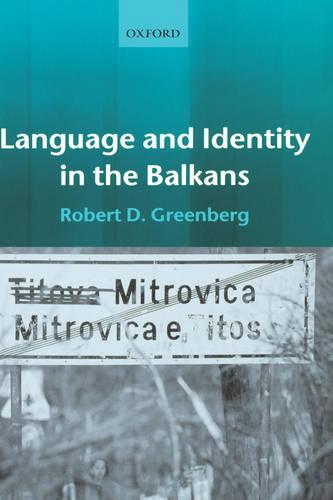Awards
- Winner of Best Book in Slavic Linguistics 2005, awarded by the American Association of Teachers of Slavic and East European Languages..
Overview
Language rifts in the Balkans are endemic and have long been both a symptom of ethnic animosity and a cause for inflaming it. But the break-up of the Serbo-Croatian language into four languages on the path towards mutual unintelligibility within a decade is, by any previous standard of linguistic behaviour, extraordinary. Robert Greenberg describes how it happened. Basing his account on first-hand observations in the region before and since the communist demise, he evokes the drama and emotional discord as different factions sought to exploit, prevent, exacerbate, accelerate or just make sense of the chaotic and unpredictable language situation. His fascinating account offers insights into the nature of language change and the relation between language and identity. It also provides a uniquely vivid perspective on nationalism and identity politics in the former Yugoslavia.
Full Product Details
Author: Robert D. Greenberg (, University of New Haven and Yale University)
Publisher: Oxford University Press
Imprint: Oxford University Press
Dimensions:
Width: 16.30cm
, Height: 1.60cm
, Length: 24.30cm
Weight: 0.450kg
ISBN: 9780199258154
ISBN 10: 0199258155
Pages: 200
Publication Date: 25 March 2004
Audience:
College/higher education
,
Professional and scholarly
,
Undergraduate
,
Postgraduate, Research & Scholarly
Format: Hardback
Publisher's Status: Active
Availability: To order

Stock availability from the supplier is unknown. We will order it for you and ship this item to you once it is received by us.
Reviews
A huge amount of research has gone into Greenberg's fine book. It is clearly written... Radmila Gorup, Slavic and East European Journal an admirable and welcome work. Its tone is particularly refreshing ... a well-crafted edition with a broad target readership in Slavic studies. Andrii Danylenko, SEER ...this is a fascinating book, well grounded in the relevant literature and written in an intelligible manner... [it will] contribute to a deeper understanding of both the dynamics and the repercussions of these disputes. Sabrina P. Ramet, European History Quarterly BEST BOOK IN SLAVIC LINGUISTICS 2005, awarded by the American Association of Teachers of Slavic and East European Languages. liThe detailed exposition and copious citation of relevant scholarly literature in many languages, together with the eminently readable text providing a masterful summation of a unique constellation of sociolinguistic phenomena, suggest that the book will become a classic reference for those who wish to study the dramatic rise and fall of the language-formerly-known-as-Serbo-Croatian.r
A huge amount of research has gone into Greenberg's fine book. It is clearly written... Radmila Gorup, Slavic and East European Journal an admirable and welcome work. Its tone is particularly refreshing ... a well-crafted edition with a broad target readership in Slavic studies. Andrii Danylenko, SEER ...this is a fascinating book, well grounded in the relevant literature and written in an intelligible manner... [it will] contribute to a deeper understanding of both the dynamics and the repercussions of these disputes. Sabrina P. Ramet, European History Quarterly BEST BOOK IN SLAVIC LINGUISTICS 2005, awarded by the American Association of Teachers of Slavic and East European Languages. liThe detailed exposition and copious citation of relevant scholarly literature in many languages, together with the eminently readable text providing a masterful summation of a unique constellation of sociolinguistic phenomena, suggest that the book will become a classic reference for those who wish to study the dramatic rise and fall of the language-formerly-known-as-Serbo-Croatian.r
Author Information
Robert Greenberg is Associate Professor of Slavic Languages and Literatures at the University of North Carolina at Chapel Hill. He received his Ph.D. from Yale University in 1991 where he taught 1991-1992. He then taught at Georgetown University before taking up his current position in 1994.




